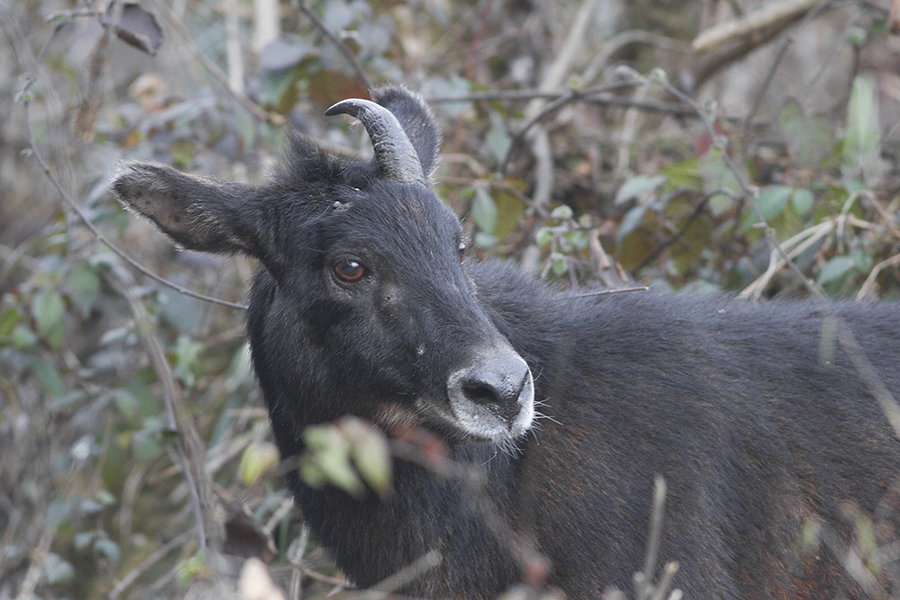Biodiversity & Environment
Himalayan Serow
- 16 Dec 2020
- 5 min read
Why in News
A Himalayan serow has been sighted for the first time in the Himalayan cold desert region (Spiti, Himachal Pradesh).
Key Points
- Description:

- Himalayan serow resembles a cross between a goat, a donkey, a cow, and a pig.
- Physical Features:
- It’s a medium-sized mammal with a large head, thick neck, short limbs, long, mule-like ears, and a coat of dark hair.
- Species Type:
- There are several species of serows, and all of them are found in Asia.
- The Himalayan serow, or Capricornis sumatraensis thar, is restricted to the Himalayan region.
- Taxonomically, it is a subspecies of the mainland serow (Capricornis sumatraensis).
- Diet:
- Himalayan serows are herbivores.
- Geographical Location:
- They are typically found at altitudes between 2,000 metres and 4,000 metres. They are known to be found in eastern, central, and western Himalayas, but not in the Trans Himalayan region.
- The Trans-Himalayas Mountain Region or Tibet Himalayan Region is located to the north of the Great Himalayas which consists of Karakoram, Ladakh, Zaskar and Kailash mountain ranges.
- They are typically found at altitudes between 2,000 metres and 4,000 metres. They are known to be found in eastern, central, and western Himalayas, but not in the Trans Himalayan region.
- Latest Sighting:
- The animal was spotted near Hurling village in Spiti, Himachal Pradesh.
- Spiti lies in the cold mountain desert region of the western Himalaya, and its valley floor has an average elevation of 4,270 metres above sea level, making the sighting special as Serows are generally not found at this altitude.
- This is the first recorded human sighting of the serow in Himachal Pradesh. The animal has been spotted a few times earlier in the state, but that has always been through camera traps.
- The animal has also been spotted in the Rupi Bhaba Wildlife Sanctuary, and in the higher reaches of Chamba.
- The Sanctuary is locally well known for its extensive alpine pastures as well as the numerous treks, trails and passes that connect it with the neighboring Great Himalayan National Park and Pin Valley National Park.
- The animal was spotted near Hurling village in Spiti, Himachal Pradesh.
- Conservation Status:
- IUCN Red List: Vulnerable
- CITES: Appendix I
- The Wildlife Protection Act, 1972: Schedule I
Salient Features of Wildlife Protection Act, 1972
- The Act provides for the protection of a listed species of animals, birds, and plants, and also for the establishment of a network of ecologically-important protected areas in the country.
- The Act provides for the formation of wildlife advisory boards, wildlife wardens, specifies their powers and duties, etc.
- The Act prohibited the hunting of endangered species.
- The Act provides for licenses for the sale, transfer, and possession of some wildlife species.
- Its provisions paved the way for the formation of the Central Zoo Authority. This is the central body responsible for the oversight of zoos in India.
- It was established in 1992.
- The Act created six schedules which gave varying degrees of protection to classes of flora and fauna.
- Schedule I and Schedule II (Part II) get absolute protection, and offences under these schedules attract the maximum penalties.
- The schedules also include species that may be hunted.
- The National Board for Wildlife was constituted as a statutory organization under the provisions of this Act.
- It is chaired by the Prime Minister.
- This is an advisory board that offers advice to the central government on issues of wildlife conservation in India.
- It is also the apex body to review and approve all matters related to wildlife, projects of national parks, sanctuaries, etc.
- The chief function of the Board is to promote the conservation and development of wildlife and forests.






